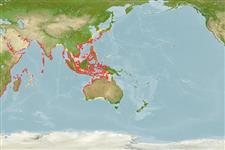Classification / Names
Common names from other countries
Main reference
Size / Weight / Age
Max length : 13.0 cm TL male/unsexed; (Ref. 189)
Length at first maturity
Lm ?, range 7 - ? cm
Environment
Marine; reef-associated; oceanodromous (Ref. 51243); depth range 5 - 35 m (Ref. 86942)
Climate / Range
Tropical, preferred ?; 42°N - 35°S, 30°E - 140°E (Ref. 189)
Distribution
Indo-Pacific: Red Sea and Persian Gulf south to perhaps Durban in South Africa, Pakistan, India, Sri Lanka, and probably Burma. Also from southern Japan to China, Philippines, Thailand, Indonesia south to Brisbane, Australia, Japan eastward to Hawaii, the Solomon Islands, Fiji, Samoa and Tahiti.
Countries | FAO areas | Ecosystems | Occurrences | Introductions
Short description
Dorsal
spines
(total): 0;
Dorsal
soft rays
(total): 12-15;
Anal
spines: 0;
Anal
soft rays: 14 - 17. Belly rounded with 3 to 6 sharp needle-like pre-pelvic scutes. Maxilla tip blunt, scarcely projecting beyond second supra-maxilla, not reaching to front border of pre-operculum. Isthmus short, preceded by small fleshy plate on urohyal between branchial membranes. Anal fin short, its origin behind base of last dorsal fin ray.
IUCN Red List Status (Ref. 115185)
Threat to humans
Harmless
Human uses
Fisheries: minor commercial; bait: usually
More information
ReferencesAquacultureAquaculture profileStrainsGeneticsAllele frequenciesHeritabilityDiseasesProcessingMass conversion
Tools
Special reports
Download XML
Internet sources
Estimates of some properties based on models
Phylogenetic diversity index
PD50 = 0.5312 many relatives (e.g. carps) 0.5 - 2.0 few relatives (e.g. lungfishes)
Trophic Level
3.3 ±0.1 se; Based on size and trophs of closest relatives
Resilience
High, minimum population doubling time less than 15 months (K=1.1-2.0)
Vulnerability
Low vulnerability (12 of 100)
Price category
